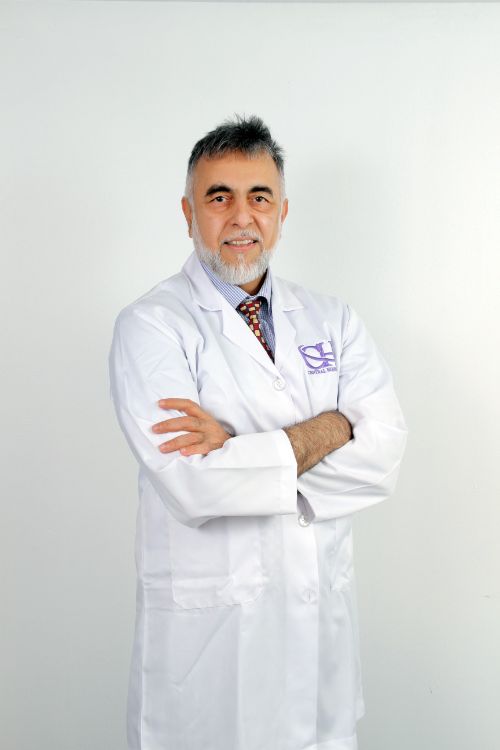General and Laparoscopic Surgery Department
Working Time
Monday – Sunday
09:00 – 22:00
Emergency Case
On Call

General and Laparoscopic Surgery Department
We offer competitive rates and packages for all procedures in the Department of General and Laparoscopic Surgery . Our Surgeons are trained to a high standard. We offer guaranteed successful outcome, so you are assured of Quality Care.
At Central Hospital Sharjah, our British trained surgeons will take care of your needs. You will be be given surgical care to a very high standard. If you require complex or major surgery or have suffered a surgical misadventure, please contact us for a solution
Elective and Emergency Surgery is available form the department of general and laparoscopic surgery.
Laparoscopic and Minimal Invasive Surgery
The Department of Laparoscopic and Minimal invasive (Access) Surgery has state-of-the-art equipment. We offer facilities for performing common as well as more complex operations. Most of abdominal operations that are traditionally performed by open surgery are undertaken using minimal access surgical technique. This has enormous benefit to the patient.
Commonly treated problems include acute appendicitis, obesity, heartburn, gallstones, hernias and colon tumors.
What is Laparoscopic Minimally Invasive surgery (MIS)
Also referred to as laparoscopic, videoscopic or keyhole surgery – is used to treat a variety of conditions. Laparoscopic or “minimally invasive” surgery is a specialised technique for performing surgery. In the past, this technique was commonly used for gynaecology and for gall bladder surgery. Over the last 10 years the use of this technique has expanded into intestinal surgery.
How it is done
In traditional “open” surgery the surgeon uses a single incision to enter into the abdomen. Laparoscopic surgery uses several 0.5-1cm incisions. Each incision is called a “port.” At each port a tubular instrument known as a trochar is inserted. Specialized instruments and a special camera known as a laparoscope are passed through the trocars during the procedure. At the beginning of the procedure, the abdomen is inflated with carbon dioxide gas to provide a working and viewing space for the surgeon. The laparoscope transmits images from the abdominal cavity to high-resolution video monitors in the operating room. During the operation, the surgeon watches detailed images of the abdomen on the monitor. This system allows the surgeon to perform the same operations as traditional surgery but with smaller incisions.
Surgeons perform these procedures through incisions as small as 1/4 of an inch. An endoscope or laparoscope – a lighted tube with a magnifying camera – is inserted through the incision, allowing surgeons to get a close-up view of the area. Because of the smaller incisions, MIS offers many benefits over conventional open surgery.
How safe is Laparoscopic surgery ?
Laparoscopic surgery is as safe as traditional open surgery. At the beginning of a laparoscopic operation the laparoscope is inserted through a small incision near the belly button (umbilicus). The surgeon initially inspects the abdomen to determine whether laparoscopic surgery may be safely performed. If there is a lot of inflammation or the surgeon encounters factors that prevent a clear view of the structures, then he will make a larger incision to complete the operation safely.
Surgery on the intestines is associated with risks such as bleeding or infection. The risk of any operation is determined in part by the nature of the specific operation. An individual’s general heath and other medical conditions are also factors that affect the risk of any operation. Please discuss with your surgeon your individual risk for the planned operation.
Services
- Disease of Esophagus e.g Esophagitis, Achalasia, Esophageal varices Gastro Esophageal Reflux Disease.
- Stomach and Duodenal disease e.g peptic ulcer and related disorders
- Intestinal Disorders e.g Inflammatory bowel disease, Disorders of absorption, Diverticular disease. Crohn’s disease, Ulcerative Colitis, Irritable bowel syndrome IBS
- Bowel Colon cancer
- Liver and biliary tract disease: Hepatitis, Cirrhosis, Ascites
Surgery performed includes these procedures
- Gastro intestinal Surgery
Gastrectomy
Cholecystectomy
Colon resection
Esophageal surgery- for reflux, esophagetomy for cancer
Perianal surgeries (Piles, Fissure, Abscess, Anal Fistula, Warts.)
Appendectomy- Colorectal Surgery
Colectomy
Anterior resection of the rectum, Abdomino-perineal excision of the rectum
Surgery for rectal prolapse - Breast Surgery
Breast Conservation Surgery, Reconstruction following mastectomy
Surgery for benign breast disease
Cosmetic Breast Surgery– Augmentation, Reduction, Nipple inversion
Breast Cancer Surgery– Mastectomy, Axillary Clearance, Sentinel Node biopsy - Other procedures
Hernia surgery
Varicose Veins
Skin Procedures
Pilonidal Sinus.
Thyroid & Parathyroid surgery
- Laproscopic surgery services
- Cholecystectomy- removal of the gallbladder.
- Nissen Fundoplication for severe gastro esophageal reflux and diaphragm hernia.
- Staging for gastrointestinal cancers.
- Appendicectomy- removal of the appendix when inflamed.
- Resection of small intestine or bowel.
- Rectopexy for rectal prolapse form descent of the rectum through the anus.
- Division of adhesions between the bowels causing repeated episodes of obstruction or pain.
- Laparoscopy for chronic abdominal pain.
- Repair of inguinal hernia and femoral hernia.
- Surgery for morbid obesity to help weight loss.
- Minimal access surgery for varicose veins.
- Ovarian tumours, ovarian masses or cysts.
- Hysterectomy or removal of the uterus in selected patients.
- Ectopic Pregnancy, when the embryo is lodges in the tubes (tubal pregnancy).
- Arthroscopy.
- Hysteroscopy.
- Treatment of kidney stones by LASER Lithotripsy
- Uretero-renoscopy with Stone blasting for kidney stones.

